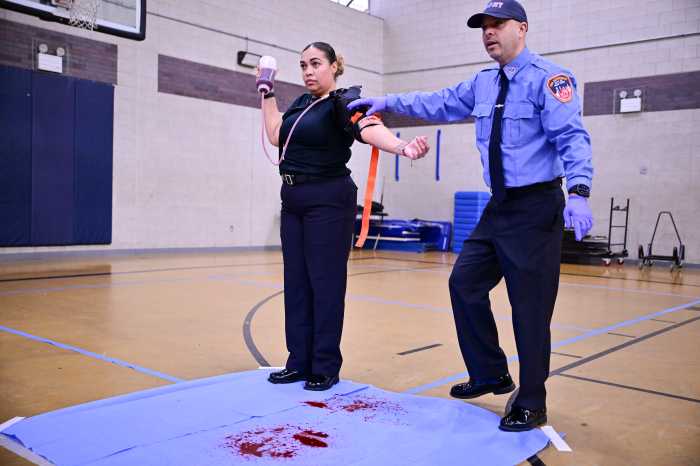Peter Staley, who paid for ads to combat crystal meth in New York more than a decade ago, hopes to see renewed activism on the issue. | SEAN BLACK
While still well below overdose deaths attributable to opioids, methamphetamine overdose deaths in New York City rose by more than 200 percent in 2015 and 2016 compared to the number of such deaths in 2013.
The city health department is reporting that there were 55 methamphetamine overdose deaths in the city in 2016 and 61 such deaths in 2015. There were 18 overdose deaths attributable to meth in 2013, putting the increases in both years at over 200 percent compared to the earlier year.
Compared to the 35 meth overdose deaths in 2014, the increases in 2015 and 2016 are smaller, but altogether the data are clearly indicating a trend of increases in deaths attributable to crystal. Compared to the 35 deaths in 2014, the 2015 deaths represent a 74 percent increase and the 2016 deaths represent a 57 percent increase.
City health department reports big increases in 2014, 2015, and 2016
For a 2016 story published in Gay City News, the city health department reported 13 crystal overdose deaths in 2013 and 34 such deaths in 2014. The agency regularly revisits and revises its data in light of new information. The original data showed a 160 percent increase in deaths in 2014 over 2013. The new data has that increase at 94 percent year over year.
In a February press release, the city health department reported that in 2016, there were “1,374 confirmed overdose deaths” and “opioids were found in 82 percent of those deaths.” Through September of 2017, the city is reporting 1,068 overdose deaths attributable to any drug though the 2017 data are provisional.
Fentanyl, a particularly deadly opioid, is implicated in the opioid overdose deaths that are currently being described as an epidemic across America. Fentanyl may have played a role in some of the city’s meth overdose deaths.
The city health department is reporting that 10 of the 61 meth overdose deaths in 2015, or 16 percent, involved fentanyl, and 16 of the 55 deaths the following year, or 29 percent, involved fentanyl. In February, the city health department reported that fentanyl “has been found in heroin, cocaine, methamphetamine, and ketamine, as well as in benzodiazepines and opioid painkillers acquired from non-pharmaceutical sources.”
The city health department has launched https://recharge.support, a website that links meth users to harm reduction services or services that can assist them in ending their meth use. It has also contracted with Gay Men’s Health Crisis and Housing Works, two HIV services organizations, to deliver services to meth users.
Deaths from meth overdoses are generally viewed as uncommon among researchers and the deaths are frequently attributed to another drug, such as an opioid, that the user was taking along with meth. The science is clear, however, that meth alone can and does kill people.
The increase in overdose deaths attributable to meth may be explained by drug traffickers, often reported to be aligned with Mexican drug cartels, manufacturing purer and more powerful meth and importing it into the US market. As with opioids, users may smoke, snort, or inject their usual amount of meth without realizing that they are getting a far greater amount of the drug. Meth kills in several ways
“Ingestions of large doses of the drug can cause more serious consequences that include life-threatening hyperthermia above 41°C, renal and liver failure, cardiac arrhythmias, heart attacks, cerebrovascular hemorrhages, strokes, and seizures,” said a 2009 study in Brain Research Reviews.
At 41°C, a person’s body temperature is at 105.8°F, which is well above the temperature at which heat stroke occurs. In a meth overdose, an elevated body temperature is a “universal presenting symptom, with lethal overdoses generally associated with extreme hyperthermia,” said a 2014 study that was published in Pharmacology & Therapeutics. That study said that the clinical diagnosis of hyperthermia comes at a body temperature at 104°F.
While the HIV activist group ACT UP founded a Crystal Meth Working Group that is continuing to work on the matter there has otherwise been little in the way of a recent grassroots response to meth use in New York City.
In 2003 and 2004, the last time that methamphetamine seized the attention of New York City’s gay male community, Peter Staley, a former ACT UP member, paid for a series of ads that ran on bus kiosks in parts of Manhattan demonizing the drug. He was eventually joined by other activists who held town hall meetings and took other actions to confront the drug’s impact. The major concern then was that meth was and remains associated with an increased risk for acquiring HIV.
“Everybody knows it’s a really persistent problem right now and much more diverse than it was 15 years ago,” Staley told Gay City News. “It’s not just the plague survivors, HIV-positive white gay men in their 40s and 50s. It is a very diverse population from an age perspective and the racial diversity seems to be much more diverse. We have very little public health discussion about it now… I’m hoping for new activism, a new discussion.”


















